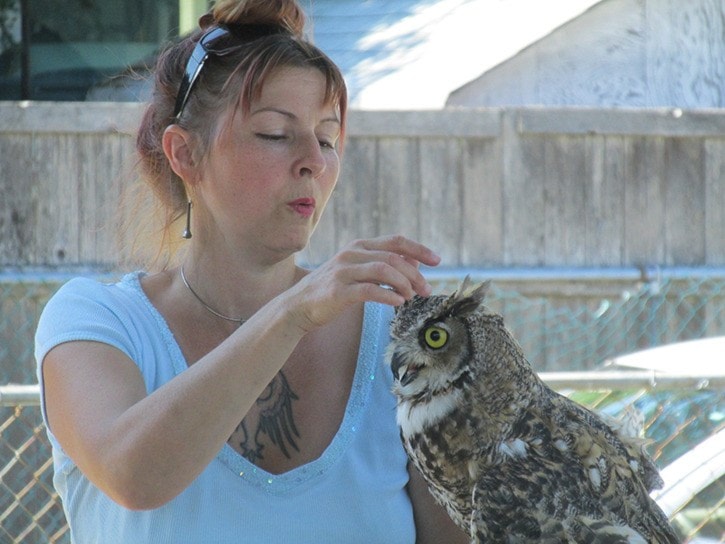Caring for an injured wild bird is hard work but at the end of the day, a hoot for Salmo resident Tammy Shaw.
Shaw is raising a one-year-old Great Horned Owl, named “Don Quixote,” after a mishap rendered the majestic bird unable to fly.
In the village, she is well known as a falconer and owner of two Harris hawks, North American birds of prey.
So when distraught neighbours showed up on her doorstep last fall asking for help with an injured bird found on their property, Shaw was quick to the rescue.
“Sure enough this young owl appeared to have flown into the side of their barn,” she explained. “He looked to be about four months old, and for a young bird learning to fly it isn’t unusual for it to fly into something.”
Shaw is qualified to tend to an injured bird for up to 24 hours by providing intervention such as fluids and a warm space to stabilize the animal. After that, injured wildlife, bird or otherwise, must travel to a vet or qualified shelter for further treatment, according to Ministry of Environment permit regulations.
“I am limited with what I can do,” she said. “I can act like an ambulance attendant so to speak,” adding, “in this case, I had him stable enough to transfer to a rehabilitation site.”
At Shaw’s request, Pacific Coastal Airlines flew the owlet, free of charge, to the Orphaned WildLife Rehabilitation Society (OWL) in Delta.
Don Quixote was treated for two compound fractures in his arm and one in his elbow, by a veterinarian who inserted a steel rod through the hollow bones in his wing.
“He was like that for four weeks,” said Shaw. “His bones were so brittle they (OWL) thought he might have to be euthanized.”
But after nine months of physiotherapy, the young owl made slow steps toward recovery. However due to tendon scarring, the bird cannot fully extend his wing and is flightless, which means he can never be released into the wild.
In May, OWL called Shaw to discuss Don’s future as an education bird, a niche that injured but otherwise healthy animals can fill.
“They called me to say the facility was full up with education birds,” she said. “And asked me if I would like him back. I said ‘oh yeah’ and applied for a permit right away.”
Today, the owl is housed on Shaw’s expansive property. During the day, he hops or walks in his large weathering area, and at night is enclosed in a “muse,” which is a secured shed.
Shaw said that few people in B.C. house owls, so she put in hours of research and had plenty of questions for the experts at OWL.
“Whenever I am down at the coast I volunteer at OWL so they really helped answer the many questions I had about caring for Don.”
She has learned that raising an owl presents time consuming challenges, especially when it comes to feeding.
“Before each feed, he has to be weighed,” explained Shaw. “Then his food gets measured in accordance to his weight.”
Certain days, the bird has to fast because in the wild an owl doesn’t always catch food. It’s the “circle of life,” said Shaw. When the owl does eat, it isn’t a job for the squeamish. Shaw makes regular “meat runs” to the coast for humanely euthanized chicken, mice and rabbits chopped to order.
“It’s a lot of work, more like a job than a hobby,” said Shaw. “I’ll never regret it, but I couldn’t do it without the help of my husband and kids.”
Shaw is already making the rounds to local libraries and summer programs to educate children about owls. The owl was the centre of attention to a group of wide-eyed youngsters Wednesday, as part of a summer parks program in Beaver Valley and Fruitvale.
Don Quixote is still quite wild in affect. Although he perches stoically on Shaw’s leather-gloved hand, he cannot be touched by others.
Just looking at the bird was enough for the kids.
The spellbound children at Haines Park were enraptured by the owl’s piercing golden eyes and very long sharp talons.
“Don Quixote is not a pet,” Shaw told the children. “He is a wild animal and that must always be respected.”
The owl will take centre stage at the Trail and District Public Library to highlight the summer reading program on Tuesday.
